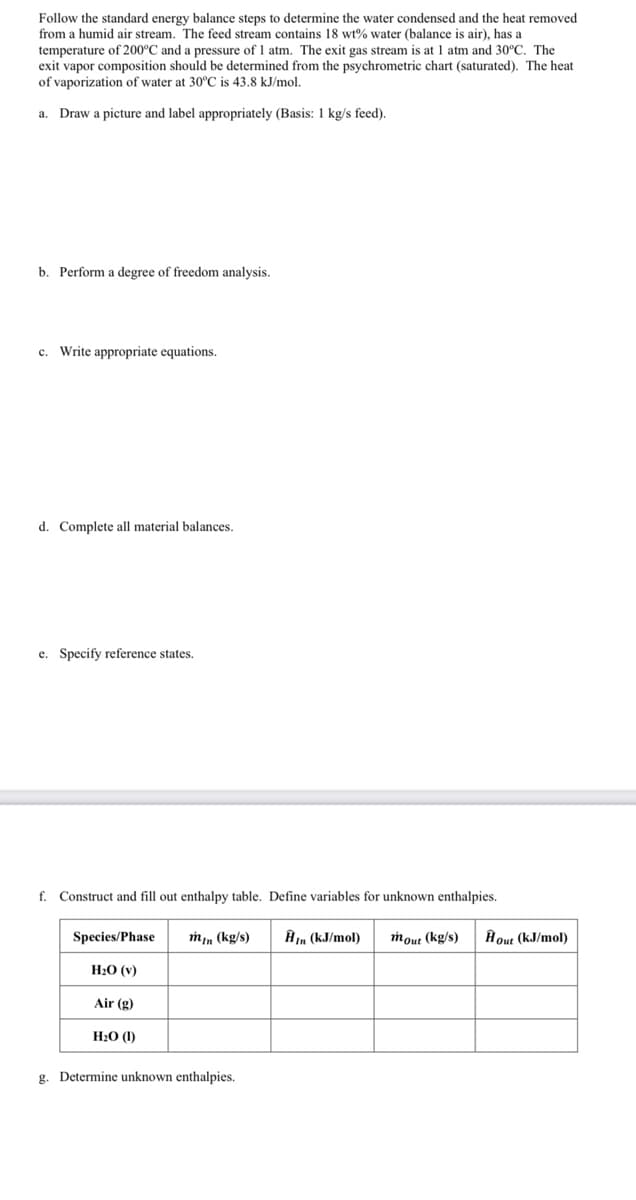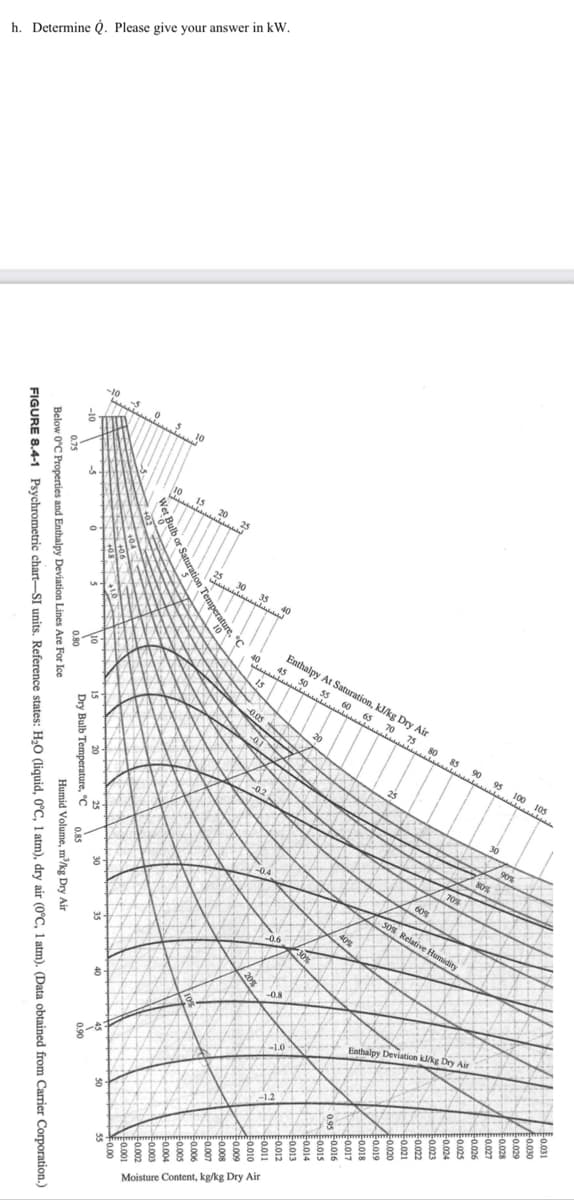Follow the standard energy balance steps to determine the water condensed and the heat removed from a humid air stream. The feed stream contains 18 wt% water (balance is air), has a temperature of 200°C and a pressure of 1 atm. The exit gas stream is at 1 atm and 30°C. The exit vapor composition should be determined from the psychrometric chart (saturated). The heat of vaporization of water at 30°C is 43.8 kJ/mol. a. Draw a picture and label appropriately (Basis: 1 kg/s feed). b. Perform a degree of freedom analysis. c. Write appropriate equations. d. Complete all material balances. e. Specify reference states.
Follow the standard energy balance steps to determine the water condensed and the heat removed from a humid air stream. The feed stream contains 18 wt% water (balance is air), has a temperature of 200°C and a pressure of 1 atm. The exit gas stream is at 1 atm and 30°C. The exit vapor composition should be determined from the psychrometric chart (saturated). The heat of vaporization of water at 30°C is 43.8 kJ/mol. a. Draw a picture and label appropriately (Basis: 1 kg/s feed). b. Perform a degree of freedom analysis. c. Write appropriate equations. d. Complete all material balances. e. Specify reference states.
Introduction to Chemical Engineering Thermodynamics
8th Edition
ISBN:9781259696527
Author:J.M. Smith Termodinamica en ingenieria quimica, Hendrick C Van Ness, Michael Abbott, Mark Swihart
Publisher:J.M. Smith Termodinamica en ingenieria quimica, Hendrick C Van Ness, Michael Abbott, Mark Swihart
Chapter1: Introduction
Section: Chapter Questions
Problem 1.1P
Related questions
Question

Transcribed Image Text:Follow the standard energy balance steps to determine the water condensed and the heat removed
from a humid air stream. The feed stream contains 18 wt% water (balance is air), has a
temperature of 200°C and a pressure of 1 atm. The exit gas stream is at 1 atm and 30°C. The
exit vapor composition should be determined from the psychrometric chart (saturated). The heat
of vaporization of water at 30°C is 43.8 kJ/mol.
a. Draw a picture and label appropriately (Basis: 1 kg/s feed).
b. Perform a degree of freedom analysis.
c. Write appropriate equations.
d. Complete all material balances.
e. Specify reference states.
f. Construct and fill out enthalpy table. Define variables for unknown enthalpies.
Species/Phase min (kg/s)
H₂O (v)
Air (g)
H₂O (1)
g. Determine unknown enthalpies.
ĤIn (kJ/mol) mout (kg/s) Hout (kJ/mol)

Transcribed Image Text:h. Determine O. Please give your answer in kW.
-10
S
65
Enthalpy At Saturation, kJ/kg Dr
0
°C
Wet Bulb or Saturation Tempera 10
12
+0.2
45 50 55 60
is
09
2
20
2
2.
8-
8
105
-9
Dry Bulb Temperature, "C
0.90
50
0.031
0.030
€0.029
0.028
0.027
0.026
E0.025
-0.024
€0.023
€0.021
E-0.020
0.019
€0.018
0.017
0.95 0.016
0.015
0.014
0.013
0.012
0.011
0.010
0.009
0.008
-0.007
0.006
0.005
0.004
0.003
0.002
0.001
-0.00
55
Moisture Content, kg/kg Dry Air
0.75
0.80
0.85
Below 0°C Properties and Enthalpy Deviation Lines Are For Ice
Humid Volume, m³/kg Dry Air
FIGURE 8.4-1 Psychrometric chart-SI units. Reference states: H₂O (liquid, 0°C, 1 atm), dry air (0°C, 1 atm). (Data obtained from Carrier Corporation.)
Expert Solution
This question has been solved!
Explore an expertly crafted, step-by-step solution for a thorough understanding of key concepts.
This is a popular solution!
Trending now
This is a popular solution!
Step by step
Solved in 5 steps with 1 images

Recommended textbooks for you

Introduction to Chemical Engineering Thermodynami…
Chemical Engineering
ISBN:
9781259696527
Author:
J.M. Smith Termodinamica en ingenieria quimica, Hendrick C Van Ness, Michael Abbott, Mark Swihart
Publisher:
McGraw-Hill Education

Elementary Principles of Chemical Processes, Bind…
Chemical Engineering
ISBN:
9781118431221
Author:
Richard M. Felder, Ronald W. Rousseau, Lisa G. Bullard
Publisher:
WILEY

Elements of Chemical Reaction Engineering (5th Ed…
Chemical Engineering
ISBN:
9780133887518
Author:
H. Scott Fogler
Publisher:
Prentice Hall

Introduction to Chemical Engineering Thermodynami…
Chemical Engineering
ISBN:
9781259696527
Author:
J.M. Smith Termodinamica en ingenieria quimica, Hendrick C Van Ness, Michael Abbott, Mark Swihart
Publisher:
McGraw-Hill Education

Elementary Principles of Chemical Processes, Bind…
Chemical Engineering
ISBN:
9781118431221
Author:
Richard M. Felder, Ronald W. Rousseau, Lisa G. Bullard
Publisher:
WILEY

Elements of Chemical Reaction Engineering (5th Ed…
Chemical Engineering
ISBN:
9780133887518
Author:
H. Scott Fogler
Publisher:
Prentice Hall


Industrial Plastics: Theory and Applications
Chemical Engineering
ISBN:
9781285061238
Author:
Lokensgard, Erik
Publisher:
Delmar Cengage Learning

Unit Operations of Chemical Engineering
Chemical Engineering
ISBN:
9780072848236
Author:
Warren McCabe, Julian C. Smith, Peter Harriott
Publisher:
McGraw-Hill Companies, The